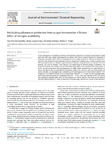Mostrar o rexistro simple do ítem
Polyhydroxyalkanoates Production From Syngas Fermentation Effluents: Effect of Nitrogen Availability
| dc.contributor.author | Portela-Grandío, Ana | |
| dc.contributor.author | Lagoa Costa, Borja | |
| dc.contributor.author | Kennes, Christian | |
| dc.contributor.author | Veiga, María Carmen | |
| dc.date.accessioned | 2022-03-14T12:24:35Z | |
| dc.date.available | 2022-03-14T12:24:35Z | |
| dc.date.issued | 2021-10-29 | |
| dc.identifier.citation | A. Portela-Grandío, B. Lagoa-Costa, C. Kennes, M.C. Veiga, Polyhydroxyalkanoates production from syngas fermentation effluents: Effect of nitrogen availability, Journal of Environmental Chemical Engineering. 9 (2021) 106662. https://doi.org/10.1016/j.jece.2021.106662 | es_ES |
| dc.identifier.issn | 2213-3437 | |
| dc.identifier.uri | http://hdl.handle.net/2183/29981 | |
| dc.description | Financiado para publicación en acceso aberto: Universidade da Coruña/CISUG | es_ES |
| dc.description.abstract | [Abstract] Syngas fermentation is a promising technology for bioalcohols production even though some produced volatile fatty acids (VFA) may remain unconsumed in the effluent. The present research explored the production of polyhydroxyalkanoates (PHA) from the remaining VFA of the syngas fermentation effluents in fed-batch bioreactors so that bioalcohols and biopolymers could be obtained in a combined way. In order to perform these PHA accumulation tests, two different syngas fermentation effluents, composed mainly of a mixture of VFA and alcohols, were used as substrate. Those effluents were characterized by different nitrogen availabilities, one being N-rich and the other N-limited. A mixed microbial culture (MMC) with a maximum PHA storage ability of 53.6% was used as inoculum. The microorganisms of the MMC mainly consumed the VFA rather than the alcohols, allowing the latter to accumulate as end product, besides PHA. However, when the N-rich effluent was used as substrate, the consumption rate of alcohols was 20 times higher (0.040 Cmmol-Alcohol Cmmol-X-1 h-1) compared to the N-limited effluent (0.002 Cmmol-Alcohol Cmmol-X-1 h-1). Despite not observing large differences in the maximum amount of accumulated PHA (40.5 – 41.5%), there was a decrease in the PHA content after reaching its maximum peak when the N-rich effluent was used as substrate. This trend was not observed with the N-limited effluent, in which the maximum PHA peak exactly matched with the end of the experiment. | es_ES |
| dc.description.sponsorship | The present work has been financially supported by the Spanish Ministry of Science and Innovation and European FEDER funds (project PID2020–117805RB-I00). The authors, belonging to the BIOENGIN group, thank Xunta de Galicia for financial support to Competitive Reference Research Groups (GRC) (ED431C 2021/55). Besides, the authors would also like to acknowledge the support of INNOLACT S. L. Funding for open access charge provide by Universidade da Coruña/CISUG | es_ES |
| dc.description.sponsorship | Xunta de Galicia; ED431C 2021/55 | es_ES |
| dc.language.iso | eng | es_ES |
| dc.publisher | Elsevier | es_ES |
| dc.relation | info:eu-repo/grantAgreement/AEI/Plan Estatal de Investigación Científica y Técnica y de Innovación 2017-2020/PID2020–117805RB-I00/ES/PROCESOS DE BIOREFINERIA SOSTENIBLE PARA LA PRODUCCION DE BIOCOMBUSTIBLES, BIOPOLIMEROS Y OTROS BIOPRODUCTOS VIA ACIDOS CARBOXILICOS/ | |
| dc.relation.uri | https://doi.org/10.1016/j.jece.2021.106662 | es_ES |
| dc.rights | Atribución-NoComercial-SinDerivadas 4.0 Internacional | es_ES |
| dc.rights.uri | http://creativecommons.org/licenses/by-nc-nd/4.0/ | * |
| dc.subject | Aerobic dynamic feeding | es_ES |
| dc.subject | Biopolymer | es_ES |
| dc.subject | Cheese whey | es_ES |
| dc.subject | Hydroxyhexanoate | es_ES |
| dc.subject | Mixed cultures | es_ES |
| dc.subject | Syngas | es_ES |
| dc.title | Polyhydroxyalkanoates Production From Syngas Fermentation Effluents: Effect of Nitrogen Availability | es_ES |
| dc.type | info:eu-repo/semantics/article | es_ES |
| dc.rights.access | info:eu-repo/semantics/openAccess | es_ES |
| UDC.journalTitle | Journal of Environmental Chemical Engineering | es_ES |
| UDC.volume | 9 | es_ES |
| UDC.issue | 6 | es_ES |
| UDC.startPage | 106662 | es_ES |
| dc.identifier.doi | 10.1016/j.jece.2021.106662 |
Ficheiros no ítem
Este ítem aparece na(s) seguinte(s) colección(s)
-
GI-BIOENGIN- Artigos [91]






